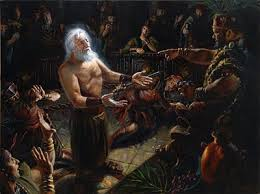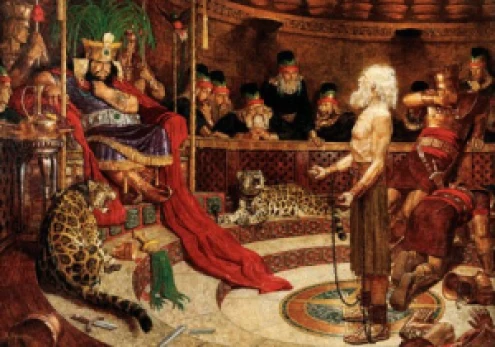This discussion of Abinadi’s teaching contains links to a few books that have helped me understand the context and content of the scriptures. As an Amazon Affiliate, I do earn a small commission from qualifying purchases (at no extra cost to you). Click here to see all of my favorite books on Amazon.
Mosiah 15-16 form the central message in the Book of Mosiah. Abinadi teaches us that Jesus Christ is both the Father and the Son. Because Jesus Christ took upon himself flesh, Abinadi informs us that he is the Son. Because of his exalted station before his birth, as the one who created the universe, he is the Father.
Regarding the fact that Heavenly Father and Jesus Christ are one, Elder McConkie had this to say:
“In the exalted family of the Gods, the Father and the Son are one. They have the same character, perfections, and attributes. They think the same thoughts, speak the same words, perform the same acts, have the same desires, and do the same works. They possess the same power, have the same mind, know the same truths, live in the same light and glory. To know one is to know the other; to see one is to see the other; to hear the voice of one is to hear the voice of the other. Their unity is perfect. The Son is in the express image of his Father’s person; each has a body of flesh and bones as tangible as man’s; and both reign in power, might, and dominion over all the creations of their hands.”[1]Bruce R. McConkie, The Promised Messiah, 9.
Elder Holland said this:
“As Abinadi taught, Christ was ‘conceived by the power of God’ (Mosiah 15:3) and therefore has the powers of the Father within him. In addition to that divine lineal relationship, Christ also acts as the Father in that he is the Creator of heaven and earth [see Mosiah 15:4], is the father of our spiritual rebirth and salvation, and is faithful in honoring—and therefore claiming the power of—the will of his Father above that of his own will.”[2]Jeffrey R. Holland, Christ and the New Covenant: The Messianic Message of the Book of Mormon [1997], 183–84.
The will of the Son was swallowed up in the will of the Father in all that Jesus did. That is, the flesh became subject to the Spirit, the mortal subject to the immortal. This is an application that can be discussed. In what ways should we seek to have our spirit rule our bodies? How can this be accomplished? How is this illustrated? Working this out and illustrating this for students will help them to see how Abinadi’s words have meaning and relevance in their lives today.
“I seek not my own will,” Jesus explained, “but the will of the Father which hath sent me” (John 5:30). This could be interpreted both ways: Jesus came to do the will of the Father (his Father, Heavenly Father) and also in the sense that he came to do the will of the Spirit, or his spirit (Jehovah). Abinadi identifies the Father as the spirit that is in Jesus, or Jehovah. The spirit of the Savior is the Father as Abinadi uses the term, “thus the flesh (Jesus) becoming subject to the Spirit (Jehovah), or the Son to the Father…” (Mosiah 15:5)
We know that Heavenly Father and his Son Jesus Christ are one, but this is not exactly what Abinadi is stressing. Rather, he is teaching the unity of the spirit and body of Jesus Christ, the very nature of the God who came to perform the Atonement.
Joseph Fielding McConkie put it this way: “Without question, Elohim and Jehovah- though separate personages- are one: one in mind, one in purpose, one in glory. Indeed, they are infinitely more one than they are separate. This has properly been referred to as the greatest teaching device ever devised in all eternity. The whole plan of salvation centers in our learning to be one with Christ as he is one with the Father. The doctrine of oneness is the doctrine of salvation!
Abinadi’s purpose in this sermon, however, is to declare more than the unity of the Godhead; his is ‘the pronouncement of pronouncements, the doctrine of doctrines, the message of messages, which is that Christ is God. And if it were not so, he could not save us. That is, Abinadi is declaring the true doctrine of Incarnation: he is teaching and testifying that God (Jehovah) will become a man (Jesus), that he who was the “Great Spirit” (see Alma 18:24-28) shall dwell in a tabernacle of clay (see Mosiah 3:5).
In summary, Christ will be both the Father and the Son. He will be called the Father because he was conceived by the power of God and he inherited all of the divine endowments, including immortality, from his exalted Sire. He will be called the Son because of his flesh- his mortal inheritance from his mother, Mary. Therefore Christ will be both the flesh and spirit, both man and God, both Son and Father. And they- the Father and the Son, the God and the man, the spirit and the flesh- are to be blended wondrously in one Being: Jesus Christ, “the very Eternal Father of heaven and of earth” (Alma 11:38-39).[3]Joseph Fielding McConkie and Robert L. Millett, Doctrinal Commentary on the Book of Mormon, volume 2, p. 230 (bold italics added).
References
| ↑1 | Bruce R. McConkie, The Promised Messiah, 9. |
|---|---|
| ↑2 | Jeffrey R. Holland, Christ and the New Covenant: The Messianic Message of the Book of Mormon [1997], 183–84. |
| ↑3 | Joseph Fielding McConkie and Robert L. Millett, Doctrinal Commentary on the Book of Mormon, volume 2, p. 230 (bold italics added). |



